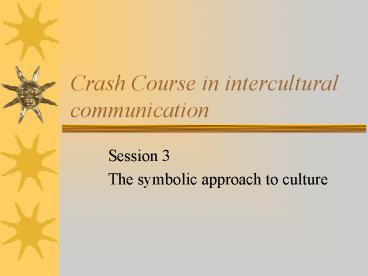Crash Course in intercultural communication - PowerPoint PPT Presentation
1 / 15
Title:
Crash Course in intercultural communication
Description:
... science in search of law but an interpretative one in search of meaning. ... Rocks and Dreams does both exist) what it means is important. ( p. 10) ... – PowerPoint PPT presentation
Number of Views:94
Avg rating:3.0/5.0
Title: Crash Course in intercultural communication
1
Crash Course in intercultural communication
- Session 3
- The symbolic approach to culture
2
Last time
- Hofstede and Hall
- Tools to handle with care
- Emic and Etic Approaches
3
Outline for todays session
- The symbolic approach to culture
- Geertz text
- What is semiotics?
- Saussure
- Peirce
- Barthes
- Exercises
4
The symbolic approach
- Covers a broad field of disciplins and
epistemological traditons - hermeneutic approach to science
- Interpretive approach
- The subject is central in the perception of
communication
5
(No Transcript)
6
Geertz view on culture
- "The concept of culture I espouse. . . is
essentially a semiotic one. Believing, with Max
Weber, that man is an animal suspended in webs of
significance he himself has spun, I take culture
to be those webs, and the analysis of it to be
therefore not an experimental science in search
of law but an interpretative one in search of
meaning. It is explication I am after. . . . (pp.
4-5)"
7
Cultural analysis
- Geertz compares the methods of an anthropologist
analyzing culture to those of a literary critic
analyzing a text "sorting out the structures of
signification. . . and determining their social
ground and import. . . . Doing ethnography is
like trying to read (in the sense of 'construct a
reading of') a manuscript. . . ."
8
What is culture?
- Once human behavior is seen as . . . symbolic
action -- action which, like phonation in speech,
pigment in painting, line in writing, or sonance
in music, signifies -- the question as to whether
culture is patterned conduct or a frame of mind,
or even the two somehow mixed together, loses
sense. The thing to ask of actions is what
their import is" (pp. 9-10).
9
- Culture is public because meaning is
- Is not in someones head
- If it exists in reality or not doesnt matter
(ex. Rocks and Dreams does both exist) what
it means is important. (p. 10) - Actor and context-oriented
10
Peirces definition of the sign
- A sign, or representamen is something which
stands to somebody for something in some respect
or capacity. It addresses somebody, that is,
creates in the mind of that person an equivalent
sign, or perhaps a more developed sign. That sign
which it creates I call the interpretant of the
first sign. The sign stands for something, its
object. (Peirce, Elements of Logic,' 228, from an
unidentified fragment c. 1897)
11
(No Transcript)
12
Barthes
- Denotation
- First order meaning
- Connotation
- Second order meaning
- Myth
- Third order meaning
13
Summing up
- All cultural phenomena is perceived as
communication between human beings - Tools and techniques
- Semiotic analysis (contradictions,
naturalisations what is evident?, themes,
aktant model) - Grounded theory
- Discourse analysis
14
Literature on Intercultural Communication Geer
tz, Clifford (1973) The Interpretation of
Cultures Jandt, Fred E (1998) Intercultural
Communiation Hofstede, Geert (1980) Culture the
software of the mind Hall, E.T. (1959) The
silent language Books in Danish Hjort, Katrine
et al (red. 1993) Interkulturel kommunikation
spændingsfeltet mellem det globale og det
lokale Jensen, Iben og Hanne Løngren (red. 1995)
Kultur og kommunikation Jensen, Iben (1998)
Interkulturel kommunikation i komplekse
samfund Peter Kvistgaard et al (19) Den
skinbarlige Hofstede, Aalborg Universitets
Forlag
15
Next time
- Danish culture from a functionalistic and
symbolic approach































